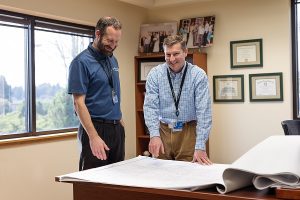By Keith Bowers
For The Corvallis Clinic
Projects aimed at reducing electricity consumption at The Corvallis Clinic brought dramatic results in 2014, yet they were only a start.
Nearing completion is a one-year, follow-up monitoring program for the Aumann Building that will achieve additional savings, while two similar efforts launched in February at nearby locations are expected to save even more.

Facilities Services Manager Anton Grube, left, has managed The Clinic’s sustainability projects since they started in 2014. “If we’re not looking for ways to be efficient,” says Clinic CEO Brad Wakefield, right, “we can’t pass those savings along to our patients.”
The four 2014 projects saw changes to interior and exterior lighting as well as heating, ventilation and air-conditioning systems. (See Clinic’s four energy-saving projects at a glance.) These efforts achieved a continuing annual savings of some $50,000 and approximately 760,000 kilowatt hours of electricity.
The Aumann follow-up effort, known as a strategic energy management project, monitors and adjusts certain air-handling and heating-and-cooling functions to make sure they’re saving as much electricity and money as possible, said Corvallis Clinic Facilities Services Manager Anton Grube.
It’s on track to finish in late April or early May and save an additional 130,000 kilowatt hours and around $7,000 annually, Grube said. Similar programs in the Asbury Building and Surgery Center commenced in February.
Grube says the effort shows how much more can be done after bigger projects are completed.
“So far it has been very successful,” said Grube.
He has monthly check-ins with representatives of Consumers Power Inc., which initiated the program, and the Bonneville Power Administration. The same two entities helped with the 2014 projects.
“I think the more efficient we all can be in everything we do, it’s a healthier way to exist,” said Corvallis Clinic CEO Brad Wakefield, “whether you’re talking about how you eat, how you get transportation, or how you heat your building.”
The money saved is also certainly worth noting.
“If we’re not looking for ways to be efficient,” Wakefield said, “we can’t pass those savings along to our patients.”
The monetary savings reflect more than just the number of kilowatt hours used, explained Thomas Elzinga, energy services manager for Consumers Power Inc.
He estimated The Corvallis Clinic’s annual savings at $49,000 in terms of kilowatt hours, but added that utilities also charge for power demand, which has decreased as well. Elzinga said he hasn’t quantified it, but he estimates the combination is “well over $50,000 in actual savings based on what they’ve done.”
Elzinga estimated the total annual savings from The Clinic’s combined efforts since 2014 at 889,000 kilowatt hours, or the equivalent of 68 homes, based on figures for the average CPI household.
Said Wakefield, “I’ve been a little surprised by how much we could save by using some of those technologies – and surprised in a good way.”
He said the idea of reducing power consumption over the long term fits with The Corvallis Clinic’s vision toward health.
“We take a long-term view of people’s health,” he said, “keeping people healthy over the next 20, 30, 40 years.” The Aumann Building program covers four areas, Grube said, including:
- Assessing and adjusting the schedules of air-handling units, which has meant starting them later in the mornings and shutting them down earlier in the evenings.
- Making sure the computers monitoring the units’ efficiency are doing their best, and making adjustments when needed.
- Inspecting the seals on the doors of the air-handling units to make sure they’re as air-tight as possible. If the seals begin to leak, Grube said, air escapes unnecessarily and the motors must work harder to provide adequate service elsewhere in the building.
- Assessing and adjusting the operational times of pumps in a perimeter-heating system that uses water. Grube said this saves electricity to run the pumps as well as natural gas to heat the water.
Asked about future conservation plans for The Clinic’s 11 buildings in Benton and Linn counties, Grube mentioned two: changing parking-area lights from incandescent to LED at the Waverly Drive location in Albany, and changing interior lighting to LED in the Philomath Family Medicine location.
Grube also cited energy-saving and sustainability efforts that go beyond electricity. The Clinic has minimized use of natural-gas powered boilers in the summer, installed low-flow water fixtures (which save water as well as natural gas by lessening hot-water use), and reduced paper consumption by transferring records to electronic systems.
Wakefield said aiming for maximum efficiency makes sense, considering The Clinic’s overall patient load varies from day to day.
“No matter how many people come in, our costs are about the same,” he said, “so we have to be efficient for the days when everyone’s feeling good and no one comes to the doctor.”
A more sustainable approach is also good for the planet.
“When you have a chance to be more efficient,” he said, “whatever that efficiency is, it feels good to do that, to be able to say, ‘I’m not consuming more than I should.'”
